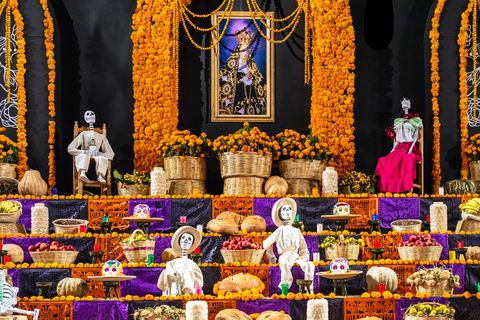Gabriel PerezGetty Images
Día de los Muertos, or Day of the Dead, honors the legacy of those who have died. Celebrated primarily in Mexico and Latin American countries, the holiday takes place on November 1 and 2. The first day, also known as All Saints’ Day in the Catholic tradition, honors children and infants who have passed, and the second day, All Souls’ Day, honors adults. The festival’s origins are deeply rooted in Aztec beliefs and tied to the goddess Mictecacihuatl, or the “Lady of the Dead.” An important part of the celebration, according to Smithsonian Magazine, involves creating an elaborate altar, or ofrenda, decorated with photos of the dearly departed, painted skulls, bottles of tequila or Mezcal, candles and symbolic flowers.
Like everything else on the altar, the chosen flowers carry deep meaning. Which specific flowers people use depends on several factors, including their availability and price point, as well as what other costumes and traditions their region employs. Let’s break down the most common blooms and what they contribute to the celebration.
Marigolds
Often called “flowers of the dead,” cempasuchil, or flor de muerto, these bright orange and yellow flowers’ fragrance is said to attract souls to the altar. Their bright and cheery color also celebrate life instead of feeling bitter about death. Real or paper marigolds appear on altars, crosses and garlands — and sometimes people even create a marigold path from their home to the altar. Remezcla reports that the earliest written mention of cempasúchil dates back to the 16th century, in the Florentine Codex. The Spanish Franciscan friar Bernardino de Sahagún described the Aztecs’ medicinal use of various flowers and plants, including the marigold’s use in a festival commemorating the dead.
Cockscomb
The terciopelo rojo or cockscomb are combined in decorations and on altars with marigolds as a prime example of how Catholic and Aztec culture intermingle in modern Day of the Dead celebrations. According to the Mexican Folk Art Guide, the deep red flower symbolizes the blood of Christ, although their brightness keeps the altar looking vibrant and cheerful, rather than the somber and dreary mood many of us in the United States associate with death and remembrance. In addition, the flowers can last up to eight weeks, especially in the hot and humid climates where they typically grow.
Chrysanthemum
White flowers also frequently appear in Day of the Dead celebrations, which is fitting because they’re said to symbolize peace, beauty and sympathy. The white chrysanthemum, in particular, is used in funerals and Day of the Dead altars, according to Cake Blog. They originate from Spain, where they appear prominently on All Souls Day and in funeral floral arrangements. Similarly, white baby’s breath may appear in Day of the Dead arrangements, often for its cloud-like clusters that lend an ethereal aura to a bouquet.
Gladiolas
You may see these long-stalked blooms laid on gravesites and tombstones during Day of the Dead ceremonies, because they traditionally represent remembrance and faithfulness in many cultures. They may be used on their own or as part of a bouquet, often with baby’s breath or other traditional blooms to round things out. It’s also an impressive-looking flower, with its long stem and showy blossoms, making it a perfect focal point for a larger arrangement.
White Hoary Stock
You may see white hoary stock used for altars remembering lost children, in particular. The flower symbolizes beauty and simplicity, according to the Mexican Folk Art Guide, and the blooms have a delicate, sweet fragrance. While the flowers also come in lots of other colors, including purple, red and blue, symbolism comes into play here. White recalls innocence, which is why you’ll typically see white hoary stock on altars memorializing those who died too young.
This content is created and maintained by a third party, and imported onto this page to help users provide their email addresses. You may be able to find more information about this and similar content at piano.io


